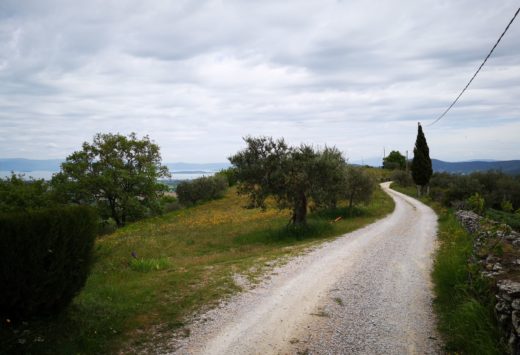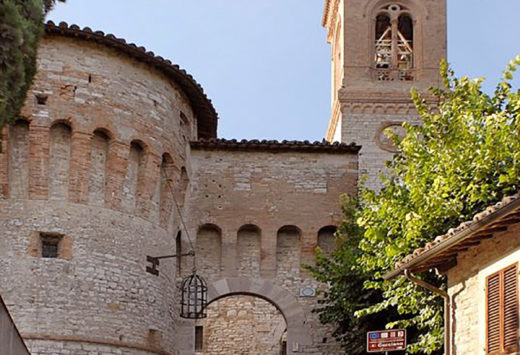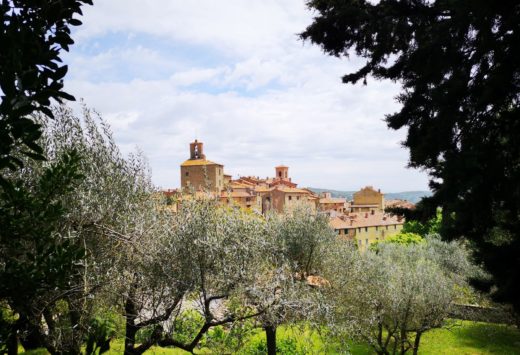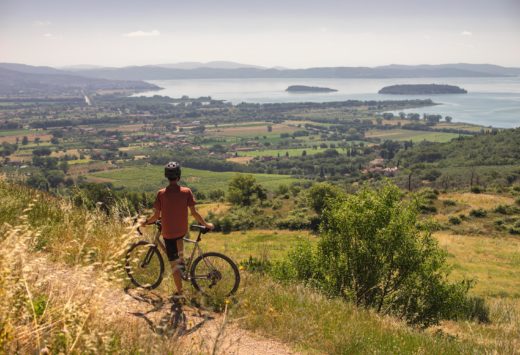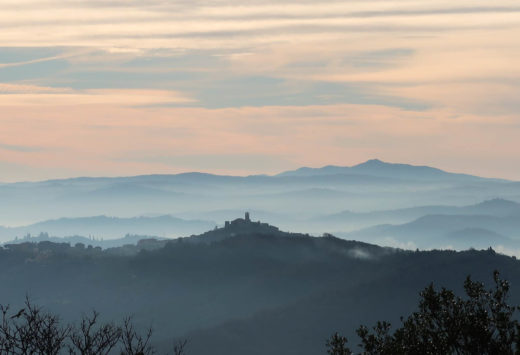Discover Città della Pieve with us
In a part of the region that borders with Tuscany and is near Lazio, at an altitude of 508 metres above sea level, stands the characteristic Umbrian village of Città della Pieve.
Its towering position on the top of a hill affords a wonderful view of Lake Trasimeno and the Val di Chiana, some of central Italy’s truly unique gems.
The village is famous for being the birthplace of the most important exponent of Umbrian painting in the 15th century, the master Pietro Vannucci known as Perugino. The painter, who was also Raphael’s master, painted captivating landscapes in his works, places that inspired and surrounded him during his life, such as the gentle hills and the lush and enveloping vegetation. The village hosts many of the numerous works painted by the illustrious artist.
Città della Pieve is now part of the province of Perugia, but the archaeological artefacts found in the area attest to how it once belonged to Chiusi; the origins of the residential centre date back to the 7th century, a period in which the Longobards exercised their power over the Duchy of Tuscia. The present name of Città della Pieve is due to a ‘Pieve’ (church) built in honour of the martyred Saints Gervasio and Protasio, and in which pagans began to be baptized and therefore converted to Christianity.
The village also took the name of Città del Castel della Pieve, due to the presence of surrounding walls dating back to the 11th century that were built to protect and delimit a castle-like fortification, but the name turned out to be too long and similar to the town of Città di Castello, so in order to avoid confusion, the village was later called simply Città della Pieve.
Village life then began to develop within it and soon the number of inhabitants grew, especially following the hardship created in the area below, as the valley of Val di Chiana gradually became a marshy area and no longer habitable, forcing the population to find shelter in the village.
Città della Pieve was for a long time subject to the harsh dominion of nearby Perugia, which definitively limited the expansion of the village with its strong and rebellious character. Only from 1228 to 1250 did Città della Pieve experience a phase of independence thanks to Federico Il di Svevia, which led to the birth of the Free Commune (or City-State), a period in which the town planning of the village was set out as we see it today. Looking at the perimeter of Città della Pieve, you can make out an interesting and curious shape of an eagle; the territory was divided into three parts, the ‘terzieri’, which correspond to the three different parts of the eagle and also symbolize the three social classes of the time: in the head of the eagle, facing towards Rome, is the Terziere Castello, which represented the class of knights and thus the aristocracy, the belly constitutes the Terziere Borgo Dentro and symbolizes the bourgeoisie, while the wing and the tail house the Terziere Casalino, which alludes to the class of the pedestrians, the peasants.
The town planning of Città della Pieve in the 13th century is fascinating to see and understand; during periods of clashes between social classes, in fact, the wide roads that developed with a curve denoted the presence of knights, who needed more space to move; these roads were in sharp contrast to the narrower ones with a fragmented surface, which showed the presence of the pedestrian class, the peasants. This way, the knights managed to escape attacks by pedestrians equipped with a crossbow and arrow thanks to the curve in the street, while the pedestrians were able to escape attack by the knights in the narrow alleyways not accessible to horses.
The ‘Terzieri’ in Città della Pieve have often been in conflict with each other and the spirit of competition has fuelled their desire to win. To re-evoke this medieval past and to celebrate the identity of the villagers, the characteristic Palio dei Terzieri is held every year in August: the village comes alive with colours, drapes and banners, the flag-wavers perform in the streets, the shops of ancient crafts, artisans and artists re-open and the age-old taverns come to life, offering delicious and succulent specialities faithful to an ancient and authentic tradition. The alleys of the village host typical Renaissance market stalls and itinerant musicians, and shows and games are held; the Terzieri challenge each other and compete for the precious tapestry of the master Antonio Marroni, which depicts the most important monuments in Città della Pieve, various archers who pay homage to the ‘Maestro di Campo’ and the symbols of the Terzieri: the medieval Castle, the Rocca del Borgo Dentro and the Pozzo del Casalino. Among the most significant events are the Corteo Storico (Historical Procession) and the Caccia del Toro (Bull Chase).
Many of the locals parade along the most important streets in the centre wearing wonderful, elegant historical costumes, representing the members of the various social classes of the past, such as knights, ladies and commoners. Passionate musicians play and evoke sweet melodies and the procession advances through the village led by the ‘Maestro di scena’ (stage manager), the Porta gonfalone (Heraldic Standard bearer) and other important personalities. Finally, a procession of about 700 people is followed by a classically-inspired allegorical float.
The Caccia del Toro ‘bull chase’ instead represents – in bloodless fashion – Siena’s ancient bullfights; the archers of the different Terzieri, each with three arrows, challenge each other with a crossbow and try to hit their respective targets, which are three wooden figures representing Chianina bulls. The silhouettes of the bulls, each with a band representing the different colours of the Terzieri, are placed on a carousel and move faster and faster, making the competition progressively more complex and exciting.
Another fascinating event for locals and tourists is the Infiorata di San Luigi Gonzaga, patron saint of the Terziere Casalino; every year, on the streets of the village, dazzling pictures are created with colourful flower petals, on a different annual theme. The event is a unique occasion and marks the beginning of Città della Pieve’s summer events.
During Easter, the village organizes a Mostra Mercato (Exhibition-cum-Market), an event that includes a display of premium, typical products connected to the agriculture, gastronomy and craftsmanship of Città della Pieve. During the same period there is also an evocative show of Quadri Viventi (Living Paintings) in which people interpret the themes of the Passion, Death and Resurrection of Christ in the incredible setting of the underground part of Palazzo Orca.
One of the unmissable events is definitely Zafferiamo, a festival that celebrates one of the most important symbols of the village, known in ancient times as the crocus. Città della Pieve in fact boasts an outstanding quality of saffron, with production cited in documents dating back to the 13th century, specifically in the Perugia Statute of 1279, which forbade the sowing of the spice to outsiders. It was originally used for dyeing fabrics and was a very important source of income for the village. Today Città della Pieve’s saffron is a premium product in Italy and is sold in threads to preserve and guarantee its quality and authenticity. During the event, which is held annually in October and does not focus solely on the use of saffron in food, you can take part in fabric-dyeing workshops using saffron pigments, or paint with the various shades of colour obtained from this valuable spice.
Over the centuries, the people of Città della Pieve have also specialized in the production of bricks, a particular sort with a reddish colour used for the majority of the houses in the village, from facades to flooring, and have also demonstrated their exquisite skills in the traditional production of crochet lace, lace and embroidery. Another famous product is panno cremisi (cramoisy), a very fine crimson fabric produced since ancient times and the embroidery created with the Punto Perugino stitch, inspired by the images and Renaissance decorations of the great artist Il Perugino.
Città della Pieve also promotes its genuine, high quality natural agri-foods. Here you taste Colli del Trasimeno D.O.C. wine and appreciate its fruity aroma and slightly bitter aftertaste and enjoy it with your meat and vegetable-based dinners; it is a predominantly red wine produced with Sangiovese or Trasimeno grapes. Equally important is the production of Colli Orvietani D.O.P. extra virgin olive oil, made from Leccino, Frantoio and Moraiolo olive varieties; its unmistakable and particularly fruity flavour and intensity will take your taste buds by storm.
Other typical specialties of the local culinary tradition are Cinghiale al dragoncello or Cinghiale allo spito (Wild boar with tarragon or spit-roasted) with its intense and decisive flavour and Zuppa di Fagiolina del Trasimeno (Trasimeno bean soup), a genuine, tasty dish with the fascinating and delicious flavour of a by-gone era.



